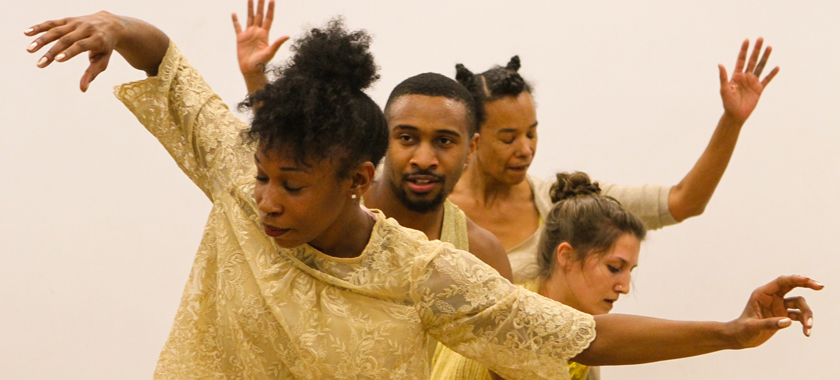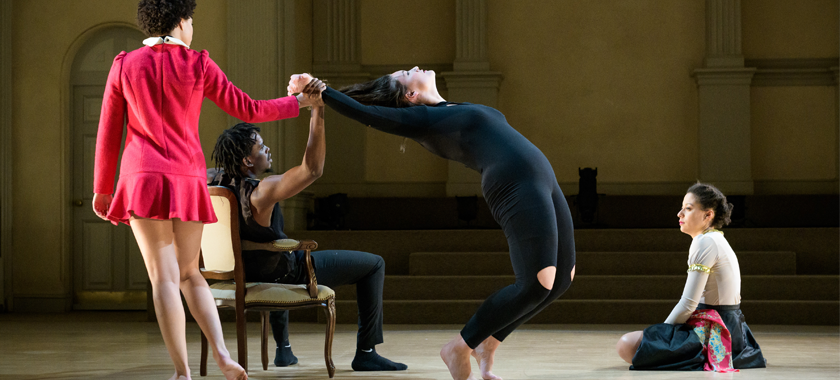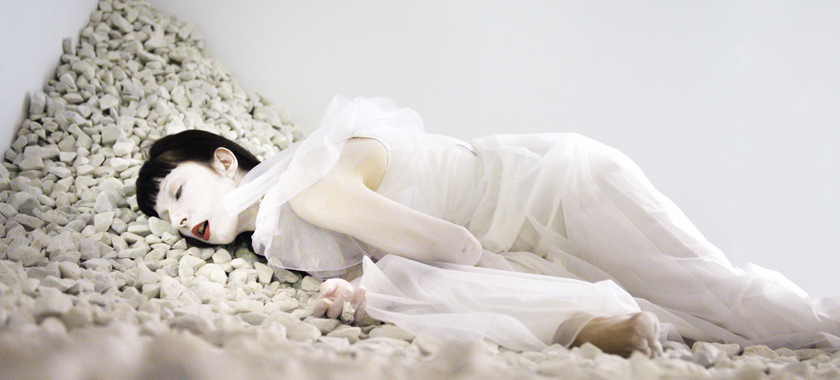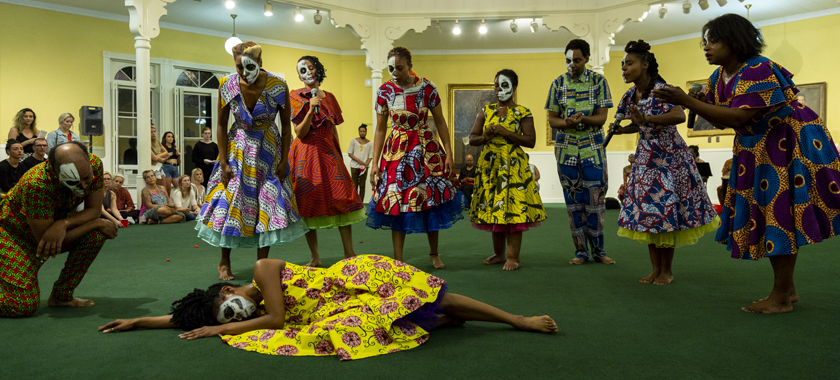
Building Community Through Dance: How Generations Support One Another
How dancer teachers and parents are shaping the future of dance and building more equitable spaces for dance to evolve and thrive.
Dance for the dancer/choreographer and for the teacher is an ever evolving practice—one that can be immensely gratifying and incredibly challenging. The one constant is the learning that comes with being in the field. With this in mind, Dance/NYC held a series of short conversations addressing the emotional, logistical, and financial issues that arise in navigating life’s many stages as a dance worker.
The conversation, part of the 2022 Digital Symposium, touched on topics including Supporting Young Dancers; Dance, Parenthood, and Artistic Practice; and Eldership and Aging in Dance. Featured speakers included:
- Alexandra Beller, Artistic Director of Alexandra Beller/Dances
- Ananya Chatterjea, Artistic Director, Ananya Dance Theatre & Coordinator, Shawngrām Institute for Performance & Social Justice
- Beverly Lopez, Artistic Director, REDi Dance Company, Dancer, Choreographer, Teaching Artist
- Makeda Thomas, Dancer, Choreographer, Artistic Director, Writer, and Curator
- Ronald K. Alexander, Self-Employed Freelance Dance Artist, Teacher, Choreographer, Administrator
- Stacie Webster, Teacher & Choreographer, Broadway Dance Center
Fostering the Next Generation
While Beverly Lopez and Stacie Webster work with two different dance communities, there is overlap in the issues that dancers face as they navigate childhood and young adulthood.
Lopez’s work through the DreamYard Project, a social justice-based arts organization that places her in a lot of K-12 public schools in New York City, centers on identity and in fostering connections between dancers through social dance. A summer dance workshop functions as an “incubator, or oasis,” something outside of students’ day-to-day routine that gives them the opportunity to focus on concepts of “myself, self-care, and healing.”
The students learn new techniques, or the basic steps of some techniques in dance styles including house, salsa and Bachata. “The meat of the work with young people is allowing them to take that information into their container, into their body, and then utilize it,” says Lopez. “Whether it’s in improvisation jams, cyphers, or in the creation process. I think it’s very important for young people to get used to the act of creating, and creating constantly and often,” she added.
The meat of the work with young people is allowing them to take information into their container, into their body, and then utilize it. Whether it’s in improvisational jams, cyphers, or in the creation process. I think it’s very important for young people to get used to the act of creating, and creating constantly and often.”
-Beverly Lopez
Webster recognized the need for dance teachers to acknowledge burnout in students, as well as “the thing of comparison that they’ve all had to go through pretty deeply.” She recently took a step back to introduce a new concept to the classroom: asking students what they need and want. “Because it’s usually like ‘what do I need from you? What do I need you to do? Instead of what does this space feel like for each person and how are you managing it? Because they all felt so much pressure, like they couldn’t take a break. And they had to keep doing this consistently or they would fall behind.”
For Lopez, balancing the objective of the performance with basic human needs–to be seen, to be understood, to be comforted–is important, acknowledging that as educators, they juggle both.
Some dance styles, like jazz, are more commercial, treating dance–and the dancer–as a product, which adds to the pressure that young dancers face. Says Webster: “They think that they are supposed to promote themselves, be marketable, be all of these many things. But it doesn’t resonate exactly with the artform, it’s more the industry talking.”

All of this is to say that teachers and mentors can help provide important context and grounding to young dancers who may not know how to set boundaries and who may not understand the origins of their dance style.
“I’ve tried to have these conversations with my students about, first of all, knowing the importance of knowing the origins, and finding people who can communicate that,” says Webster. “If they know these things, it comes from a more whole place. They will respond to the information, they get it. I always encourage them to question ‘what are we going for, why are we here, and how do we protect ourselves.’”
The most beneficial thing a dance teacher can bring to their students? “Our creativity in this space,” says Webster. “I try to create work for my students that they can identify with. I try not to pick topics that are unavailable to them. Everyone can dance about losing someone, or we can dance about finding that moment in life where we want to keep going, or acceptance. I try to craft my work around something they can really dive into. And when students are given the space to grow, that’s the most beautiful thing,” she added.
I try to create work for my students that they can identify with. I try not to pick topics that are unavailable to them…I try to craft my work around something they can really dive into. And when students are given the space to grow, that’s the most beautiful thing.
-Stacie Webster
The Artist-Parent Life
Alexandra Beller and Makeda Thomas are artist parents whose children are part of the larger dance community. Though they recognize how scary it can be to become a parent whose work is intimately tied to their body, they spoke mainly of the positives that come with having children as a dance artist, highlighting that children have sharpened their focus and given them new perspectives as creatives.
For Thomas, her kids learn not only from her, but from dance artists who are their aunties, uncles, and friends. “They’ve been fed during rehearsal and listened to lectures—which I know they understand nothing—but somehow were connecting, following choreography, traveling through airports around the world, and performing with me as babes in arms. We live a transnational life between New York City and the Caribbean. And perhaps, I could have known, but what was affirmed for sure, was how much your village, your community, and dance are actually going to support you through this journey,” she said.
And perhaps, I could have known, but what was affirming for sure, was how much your village, your community, and dance are actually going to support you through this journey [of motherhood].
-Makeda Thomas
In her early motherhood, Thomas was invited by Ananya Chatterjea, another Dance/NYC panelist, to participate in a residency in Minnesota. “Through that community of dancer workers, it really taught me that ‘yes, you can really do this and be supported.’ Having that support allowed me to be as bold and brave and as fearless as I have been. But yes, it is work and it can be scary.”
“The community of artists in which I work expects my children to be present. That’s the only way that I can do what I do,” Thomas continued. “It doesn’t mean that there haven’t been times when I had invitations to do things and there were zero accommodations for children. And so, I didn’t do those things.”

Beller acknowledged that she grappled with herself about what felt ‘fair’ to ask for when traveling with children. “You bring my company in and all of a sudden you pay for two more? Is that fair to the presenter? But then, there’s a flip side to it. It costs me that much to travel, and I have to spend my entire salary to be a parent artist. Is that fair to me? There’s some area in between in which we’re trying to be understanding of each other. I do think the world needs to shift a lot more to allow parents to exist in the world as fully formed human beings.”
She’s made inroads by asking for tech riders for childcare that would be covered, and for a living space that would be amenable for children. She’s given herself concessions, like taking breaks not only for her students, but for herself and her children. “There’s a battle to fight with the stigma around being a parent creator. There still remains quite a bit of stigma of ‘if you’re a parent then you’re not really about your art, you’re a hobbyist.’”
There’s a battle to fight with the stigma around being a parent creator. There still remains quite a bit of stigma of ‘if you’re a parent then you’re not really about your art, you’re a hobbyist.’
-Alexandra Beller
And while Beller initially tried to separate her children from her dance life, she found it easier to let the two blend together. “I tried to protect my dancers from my children for a long time,” she says. “And then I realized that it was not only unnecessary, but actually counterproductive. And so then I embraced the lifestyle of integrating my children into my full life. I want my art to be learning from my children. It did just become that they were part of the family of my company, and that was really beautiful,” she added.
Having children helped Thomas make new traditions and rituals, resulting in new ideas about what home and family even mean, or could look like. “And figuring out how to carve time to and from artistic practice and family and having them all mix up,” she added. On the topic of time management, Thomas says: “It’s not haphazard, but it’s just so clear. There’s just so little room for clutter that I can see it very clearly, and it’s literally all the time I have, and next!”
Considering becoming a parent? Thomas recommends that partners have a series of honest conversation about what that labor will look like, given the fact that “one person of the couple is going to have a lot of credit from the beginning, their whole body is going to be affected. It can breed a lot of resentment without deep, deep honesty, and willingness to sacrifice. Know that you’re not going to have the time you had before to do anything. Just know that if you thought you could apply for five grants, you can do two. And just really shift. If you don’t shift, it’ll become overwhelming.”
Added Beller: “My advice is similar. If you are in a partnership, there’s a lot of reckoning with value as separate from money. As an artist in general, that is a question that we all face.”
Being In Service To Dance
Ronald K. Alexander and Ananya Chatterjea have trained generations of dancers, giving back to the art form and embedding their generosity and values into students and peers who are pushing dance forward in their footsteps. Both dancers are still dancing today, with the strong work ethic and dedication to their craft that was instilled in them from a young age.
Says Chatterjea: “I trained only in South Asian dance forms. My gurus were unwavering, whether you were tired or not. They were not going to consider that. While that felt really hard in some ways, what I learned was ‘dance is bigger than me.’ If I am to be of service in this field, how can I be really aligned with what dance is? For me, it’s a spiritual practice.”
My gurus were unwavering, whether you were tired or not. They were not going to consider that. While that felt really hard in some ways, what I learned was ‘dance is bigger than me.’ If I am to be of service in this field, how can I really be aligned with what dance is? For me, it’s a spiritual practice.
-Ananya Chatterjea
In reflecting on the challenges of dance as you age, Chatterjea notes that it “is a very humbling practice. First, I could train really hard and I was ready for dancing. Then, I had to do yoga before I trained even with more determination so I was stretched. Now, I have to do some other things: I have to do Pilates, then I have to do yoga, and I’m ready. So the practice just gets longer. But that’s what I have to do because I am in service.”
Alexander’s teaching and practice are also in service of the art form. “When I worked with Arthur Mitchell (of Dance Theatre of Harlem), and I always refer to him as Mr. Mitchell, he reminded us constantly that we were in service to the art form. So the art form at that particular institution–of course it was ballet–you know, you were subservient to it. You as a teacher, as an artist, as an administrator, it was the training of the students, it was the training of the professional dancers. That was the most important. Not your ego.”

What inspires Alexander and Chatterjea are the artists that they train and work with. Chatterjea has learned that training the next generation of artists and inviting and building a platform is one of the parts of the work she’s most proud of. “Especially because I work with BIPOC women and femmes,” she says.
“Part of our generation’s work has been to build platforms,” she continued. “Very often we find that dance, even a generous and beautiful practice like dance, has been co-opted by capitalism. So we are constantly in this competitive mode, so I feel like my life’s work has been, I hope, to deflect that as much as possible. I’m proud that artists who have worked with me are getting their own recognition in terms of awards and fellowships, and doing their own work. And I hope to keep supporting that.” By creating a more sharing, community-driven approach to dance, Chatterjea is discouraging aspects of the industry that can have a negative impact.
To conclude, Alexander spoke about going to performances and proudly seeing his students on stage. “When I say ‘my students’ I see students from Alvin Ailey Company, Dance Theatre of Harlem, I was there and helped to train them. It’s just getting back to what Arthur Mitchell said ‘you are in service to the artform,’ and that’s what I feel I continue to do.”
It’s just getting back to what Arthur Mitchell said ‘you are in service to the artform,’ and that’s what I feel I continue to do.
-Ronald K. Alexander
Interested in more dance content? Check out these posts:
- Beyond Labels: Seven Dancers Share Lessons From Their Careers
- Strategies for Submitting a Strong Performing Arts Application
- How to Monetize and Build Online Performance Projects
- Navigating the Grant Application Process as a Performing Artist
- Performing Outdoors
You can find more articles on arts career topics by visiting the Business of Art section of NYFA’s website. Sign up for NYFA News and receive artist resources and upcoming events straight to your inbox.